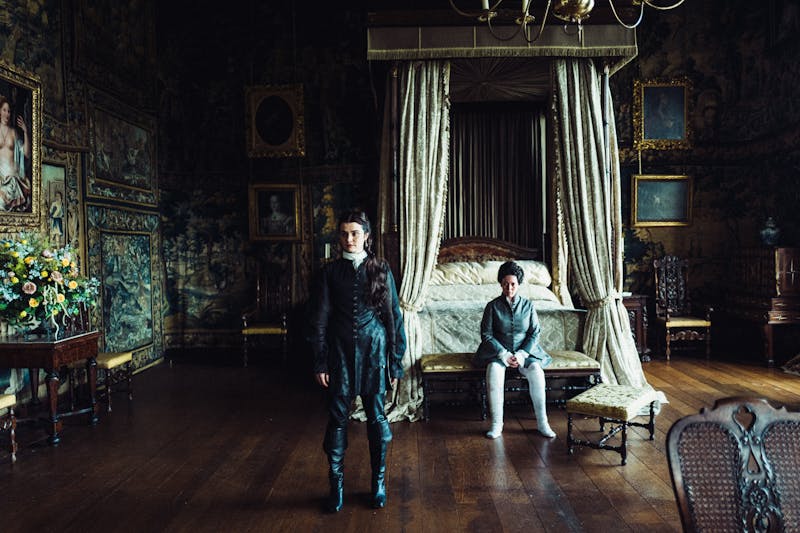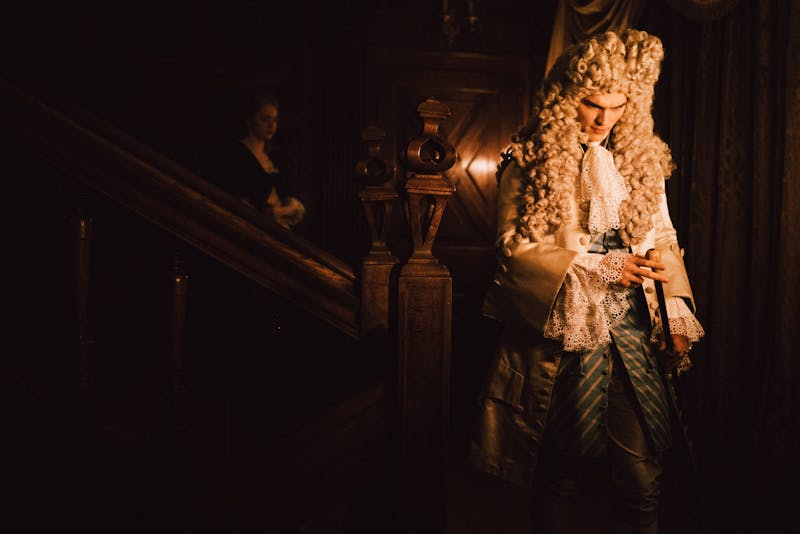Our world is lit by electricity. Even at night, the city sky is clouded by the orange haze of anthropogenic light. The words for different types of light pollution are magnificent: light clutter, skyglow, light trespass. We also use electricity to make movies—to film them, to light their sets, to illuminate a pair of eyes. The filmmaker who wants to faithfully depict historical worlds, therefore, is in a bind. How do you light a world that most of us have never known? How do you capture a story free of skyglow?
The Favourite, directed by Yorgos Lanthimos (Dogtooth, The Lobster, and The Killing of a Sacred Deer), shows us a new way to see the past. Unlike his previous movies, which were all invigoratingly contemporary, The Favourite is set in the eighteenth century, during the reign of Queen Anne (played by Olivia Colman). Its action is based on the true story of Anne’s close-to-obsessive relationship with her courtier Lady Sarah Churchill, Duchess of Marlborough (Rachel Weisz), and the usurping of the Queen’s affections by a younger woman named Abigail Hill (Emma Stone). It’s a lascivious and decorative old tale, with a generous layer of lesbian sex (though, sadly, mostly off-screen). Imagine the erotic intrigues of The Handmaiden (2016) crossed with Barry Lyndon (1975), starring Rachel Weisz in a leather riding habit.
The performances are very good, in particular a single derisive snort that Emma Stone gives out of one side of her face. But the heart of this movie is in its scenery, its costuming, and, in particular, the way Lanthimos lights those materials. Barry Lyndon used the lenses that NASA developed for the moon landing, which allowed Stanley Kubrick to shoot in extremely low light, creating what critic Tim Robey called the “huddle and glow of a pre-electrical age.” Lanthimos and his director of photography Robbie Ryan (Philomena, The Meyerowitz Stories) seem to have worked directly in the Kubrick tradition. Shot in 35mm, the movie’s production notes describe a shoot almost totally free of electrical lighting, except in a couple of outdoor shots.

That naturalism is period-specific, of course, but also specific to the days when the movie was made, per Lanthimos: “When there are sunny days the scene is sunny, when there are gloomy days it’s darker.” Wide angle lenses work hard to capture the glorious checkered floors and golden ceilings of Hatfield House, a huge Jacobean mansion in England’s Hertfordshire, where the movie was filmed. One wonders how they got permission to use all those drippy candles.
The camera spins around our three central women, who also each spin in different scenes. Abigail toys with a male suitor in the woods, and he lifts her to whirl her around; Sarah dances at court to a bizarre choreography, which also requires she be lifted and spun. It’s a symphony in disorientation, underscoring the bewilderment each character experiences as their ménage a trois shifts its balance.
If The Favourite is an exercise in naturalism, it also contains a profound artifice. Each scene is an elaboration of raw materials, like a headdress sculpted out of fruit. The tapestries that cover the walls of the Queen’s bedroom seem to hold the blue English daylight coming in from the windows. As in Bergman’s Fanny and Alexander, these fiber-and-wood interiors feel shockingly new to our plastic-adjusted eyes. One morning, Abigail rides out to the woods in search of herbs to soothe Anne’s gout. The dawn light is the slightest cobalt glow, with Hatfield House’s wisteria flowing down the walls in a lavender rain. When Sarah goes missing, riders seek her with flaming torches against a sky so indigo that it looks like paint.
The daylight feels like fresh water; the candlelight yellow and greasy like an overly aged Chardonnay. Fire is cooled against white marble. A white rabbit hops on a dark hardwood floor. A single teardrop blazes against Emma Stone’s daylit cheek. Politicians cavort by night, throwing fruit in slow motion at a laughing naked man, cut against shots of Sarah galloping into the woods on a black horse. Bare trees in the moonlight, bare bums in the palace—both shine.

I understand pearls now, having seen them filmed this way. Oddly, I also understand the powdered wigs and mouches of the men of this time; Nicholas Hoult as the politician Robert Harley is bitchy and radiant in his makeup. Most of his scenes are interior and at night, as he stalks the house holding candles, lighting himself like Caravaggio’s David against the black. Hair and makeup designer Nadia Stacey explains, “It’s probably the only period in history where the men were so much more adorned than the women.” Anne, Sarah, and Abigail are mostly barefaced, though their changing appearances track their fortunes. As Abigail gains power, her hair gets higher, while the descending Sarah is injured by a horse, forcing her to wear a streak of black lace against her face.
The script is splashy and acidic. Sarah tells the queen that she looks “like a badger” in makeup. One male politician keeps a duck named Horatio on a leash. “Must the duck be here?” Harley asks. The answer: “Horatio is the fastest duck in the city!” Sarah keeps the Queen’s books, and derides a staffer for exceeding her “tapestry budget.” The political context is the war in France, with the Whigs and Tories each beseeching Anne to go in a different direction. It’s a fairly straightforward allegory of the fight between Abigail and Sarah, but it also gives Hoult a chance for some great lines. In one scene, he extorts Abigail for information. “Oh look, a wren, how cute,” he says, before pushing her in a ditch. As Sarah makes one final attempt at bullying Abigail, the new royal pet retorts, “All I know is, your carriage awaits and my maid is on her way up with something called a pineapple.”
Weisz and Stone are both very sexy, the former dominant and swaggery and the latter babyfaced and manipulative. But it’s Colman, who has risen from British television (Peep Show, The Crown, Broadchurch) to Hollywood (The Lobster, Hyde Park on Hudson) in recent years, who outperforms everybody. Even though she’s the queen, we pity her loneliness, her grief over her lost babies, and the sickness that would ultimately kill her at 49.
The Favourite needs to be understood as a tribute to Kubrick’s film, but also as a bright new island in Hollywood’s dull sea of CGI. Bathed in a score of Vivaldi, Bach, and Purcell, it’s Lanthimos’s most watchable movie to date, and also his best. The Favourite is a triumph in textures, a beam of light through a window.